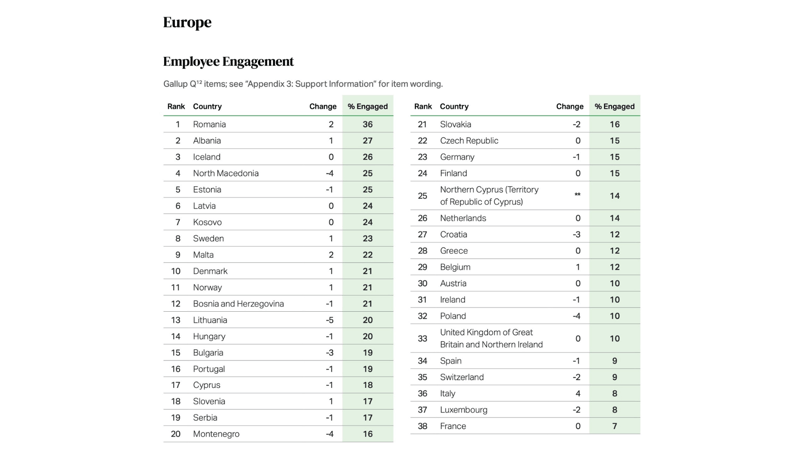Gallup estimates low employee engagement costs the global economy 8.9 trillion U.S. dollars, or 9% of global GDP.
From Suffering to Thriving: The Role of Work in Employee Mental Health and wellbeing
In 2023, global employee engagement stagnated, and overall employee wellbeing declined. Although both measures remain at or near record highs, their lack of improvement is significant, especially after multiple years of steady gains. Consequently, the majority of the world’s employees continue to struggle at work and in life, which directly impacts organisational productivity. Gallup estimates that low employee engagement costs the global economy US$8.9 trillion, or 9% of global GDP.
To enhance employee engagement and improve the health and productivity of the global workforce, leaders must implement effective employee engagement strategies. In this report, we explore the current state of employee mental health and wellbeing at a global level. We then delve into the economic and policy-related factors influencing employee wellbeing, followed by an analysis of manager-related factors that affect engagement at work and overall thriving in life. Additionally, we conducted follow-up interviews with respondents worldwide to gain insights into their feelings about their work. Examples of their responses are included throughout this Research Summary to highlight the benefits of employee engagement and its impact on employee retention, employee experience, and workplace productivity.
Employee engagement is a significant factor in overall life experiences.
.png)
.png?width=800&height=450&name=Positive%20Experiences%20(LP).png)
Not all mental health issues are directly related to work, but work plays a significant role in life evaluations and daily emotions. Employees who are dissatisfied with their jobs often experience high levels of daily stress and worry, along with elevated levels of other negative emotions. On many wellbeing indicators—such as stress, anger, worry, and loneliness—being actively disengaged at work can be as detrimental as, or even worse than, being unemployed.
In contrast, when employees find meaning in their work and work relationships, employment is associated with high levels of daily enjoyment and low levels of negative emotions. Notably, half of the employees who are engaged at work are thriving in life overall. For employers, enhancing employee engagement and supporting mental health are crucial strategies for improving employee satisfaction and retention. This involves providing appropriate benefits, flexibility, and employee resource groups to support overall wellbeing. However, employers should not overlook their most powerful tool for enhancing employee life evaluation: building productive, high-performing teams aligned with company values.
To maximise the benefits of employee engagement, frequent employee engagement surveys can be used to gather insights and identify areas for improvement. These surveys, coupled with effective employee engagement strategies, are key to fostering a positive employee experience, improving workplace productivity, and ensuring long-term employee retention.
In best-practice organisations, three-fourths of managers are engaged, as well as seven in 10 non-managers.
.png?width=800&height=450&name=Annual%20Employee%20Engagement%20Globally%20(LP).png)
While only 30% of managers and 23% of employees globally are engaged, some organisations achieve significantly higher levels of employee engagement and wellbeing. Best-practice organisations across various industries and geographies have three-fourths of their managers engaged, along with seven in 10 non-managers. This translates to a remarkable ratio of 14 engaged employees for every one actively disengaged employee, which is 11 times the global average.
Since 2020, the global workplace has undergone significant changes. The rise of hybrid work for remote-capable employees has complicated people management, while even on-site employees are demanding greater autonomy in their work lives. Additionally, the mental health of younger workers has emerged as a pressing concern. These trends necessitate new strategies for managing and engaging employees.
Many of the organisations studied by Gallup did not initially have high levels of employee engagement. Achieving such high engagement was the result of intentional leadership efforts over several years. Leaders who cultivate strong and resilient company cultures focus on several key areas that distinguish them from other organisations:
- Prioritising Manager Hiring and Development: The manager-employee relationship is the cornerstone of employee engagement and a crucial factor in overall employee wellbeing. Leading organisations hire managers with a natural talent for engaging their teams and train them to become effective coaches who provide meaningful feedback that drives improved performance.
- Integrating Engagement into the Employee and Manager Life Cycle: These organisations make employee engagement a central business strategy, incorporating it into every stage of the employee and manager life cycle. This includes how they hire, onboard, coach, and develop talent, as well as how they approach performance management, goal setting, team meetings, and manager-employee conversations. Engagement is embedded in their company culture—it's simply how they do business.
- Emphasising Wellbeing at Work and in Life: Top organisations consistently support employee wellbeing, making their commitment visible and continuous. Many employ dedicated wellbeing teams with counsellors or coaches, offering resources beyond physical health, such as financial literacy, planning support, and mental health webinars. They also encourage community involvement. By focusing on these areas, these organisations enhance both employee lives and organisational performance.
In summary, the benefits of employee engagement are far-reaching, improving employee retention, experience, productivity, and overall workplace satisfaction. Leaders can take actionable tips from these strategies to build a strong company culture that supports and retains talent, leading to long-term success.
.png?width=800&height=450&name=Gallup%20Engagement%20(LP).png)
When organisations increase the number of engaged employees, they improve a host of organisational outcomes.
Gallup's 2024 meta-analysis, the largest study of its kind, provides compelling evidence that reducing the number of disengaged workers leads to positive outcomes within organisations. Analysing data from more than 183,000 business units across 53 industries and 90 countries, Gallup found that business units with high employee engagement are significantly more likely to experience enhanced employee wellbeing, increased employee productivity, and higher profitability and sales compared to low-engagement teams.
The benefits of high employee engagement are clear: a more engaged workforce leads to a better employee experience, greater workplace satisfaction, and improved organisational performance. To achieve these outcomes, organisations should focus on powerful steps like providing employees with flexibility, gathering frequent feedback, and implementing top employee engagement tips. By prioritising employee engagement strategies, businesses can create a more dynamic and productive work environment.
.png?width=800&height=450&name=Outcomes%20of%20Highly%20Engaged%20Business%20Units%20(LP).png)
Developing highly engaged teams leads to fewer negative outcomes, more positive results, and greater overall success for your organisation.
Top-quartile teams in employee engagement consistently achieve higher performance in positive outcomes and experience fewer negative outcomes. Bottom-quartile teams face more negative outcomes and struggle to achieve strong performance in positive areas. This highlights the critical role of employee engagement in driving business success.
To cultivate high engagement, focus on strategies that enhance the digital employee experience, promote effective communication, and encourage regular feedback. Recent employee engagement articles emphasise the importance of providing professional development opportunities, coordinating volunteer activities, and planning company outings. Training managers to foster engagement and support their teams is also crucial for sustaining a productive and motivated workforce.
.png?width=800&height=450&name=Global%20Summary%20Employee%20Engagement%20(LP).png)
.png)
-1.png?width=1200&length=1200&name=Employee%20Engagement%20Regional%20Ranking%20(Social%20Media)-1.png)
%20(1)-1.png?width=1200&length=1200&name=Employee%20Engagement%20Stats%20(LP)%20(1)-1.png)
.png?width=800&height=450&name=Daily%20Sadness%20Stats%20(LP).png)
.png)
.png?width=800&height=450&name=Intent%20to%20Leave%20Stats%20(LP).png)
.png?width=800&height=450&name=Employee%20Engagement%20Work%20Location%20(LP).png)
.png?width=800&height=450&name=Daily%20Loneliness%20Work%20Climate%20(LP).png)
.png)
%20.png?width=800&height=450&name=European%20Countries%20Included%20(LP)%20.png)
TOP TAKEAWAYS
1. Lowest regional percentage of engaged employees.
2. Lowest regional percentage of employees who say they are watching for or actively seeking a new job.
3. Second lowest regional percentage of employees experiencing daily sadness.

Meta Quest 3S useful Links
- Meta Quest 3S features
- Meta Quest 3S cheaper and nearly as good as 3S
- Discover the Meta Quest 3S
- Meta Quest 3S v Meta Quest 2
- Meta Quest 3S price comparison is it worth it?
- Order the Meta Quest 3S
- Meta Quest 3S price revealed
- Meta Quest 3 clock speed
Meta Quest 3 Useful Links
- Quest 3 128gb discontinued in favour of Quest 3S
- Meta Quest 3 connecting it to your pc a quide
- Meta Quest 3 2024 updates
- Meta Quest 3 v Pico 4
- Meta Quest 3 and Windows 11
- Meta Quest 3 collaboration with Photon
- Meta Quest 3 price cut
- Meta Quest 3 remote Desktop Link
- Meta Quest 3 boost productivity
- Meta Quest 3 v PS5
- Meta Quest 3 Beginners guide
- Meta Quest 3 v Meta Quest 2
- Meta Quest 3 v Apple Vision Pro
- Meta Quest 3 v Meta Quest 3S price comparison
- Meta Quest 3S v Pico 4
Enterprise Useful Meta Quest Links
- Microsoft & Meta - Why are the important for businesses
- Meta Quest for Business FAQs
- Meta Quest 3 and Mesh the future of collaboration
- Meta Quest workplace benefits

